Figure 2. A variety of events indicating a need for control are associated with a similar neuroelectrical signature in the theta band (~4–8 Hz) over mid-frontal sites.
Rows depict different components of the event-related electrophysiological signal, columns show different events associated with increased demands for adaptive control. (A) Event-related potential (ERP) components in the time-domain. N2: an ERP component evoked by exogenous cues of novelty or conflict. Feedback Related Negativity (FRN): An N2-like component evoked by exogenous feedback signaling loss or punishment. Error Related Negativity (ERN): A massive ERP component evoked by commission errors. While these ERP components (i.e., peaks and troughs in the wave) are related to learning and adaptive control, they represent a small fraction of ongoing neural dynamics: signal averaging in the time-domain imposes a substantial reduction in potentially meaningful information. (B) The full spectral dynamics of event-related neuroelectrical activity depicted in time-frequency plots. Here, significant increases in power to conflict, punishment and error are outlined in black, revealing a common feature in the theta band (~4–8Hz). (C) Scalp topography of event-related theta activity. The distribution of theta power bursts is consistently maximal over the frontal midline. Data and statistical tests from (Cavanagh et al., 2012b).

